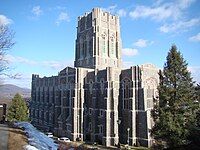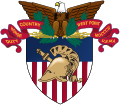
The United States Military Academy (USMA), also known metonymically as West Point or simply as Army, is a United States service academy in West Point, New York. It was originally established as a fort, since it sits on strategic high ground overlooking the Hudson River with a scenic view, 50 miles (80 km) north of New York City. It is the oldest of the five American service academies and educates cadets for commissioning into the United States Army.

Alden Partridge, was an American author, legislator, officer, surveyor, an early superintendent of the United States Military Academy at West Point, New York and a controversial pioneer in U.S. military education, emphasizing physical fitness training, advocating the concept of citizen soldier and establishing a series of private military academies throughout the country, including Norwich University.

The Superintendent of the United States Military Academy is the academy's commanding officer. This position is roughly equivalent to the chancellor or president of an American civilian university. The officer appointed is, by tradition, a graduate of the United States Military Academy, commonly known as "West Point". However, this is not an official requirement for the position.
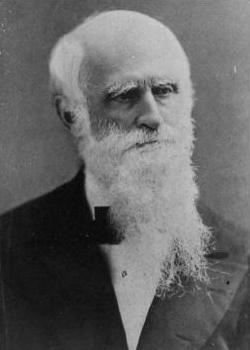
Henry Brewerton was a career engineering officer in the United States Army, serving as the superintendent of the United States Military Academy and then as a colonel in the Union Army during the American Civil War. He was nominated for appointment to the grade of brevet brigadier general in the Regular Army by President Andrew Johnson on December 11, 1866, to rank from March 13, 1865, and the United States Senate confirmed the appointment on February 23, 1867.

The United States Air Force Academy Cadet Chapel, completed in 1962, is the distinguishing feature of the Cadet Area at the United States Air Force Academy north of Colorado Springs. It was designed by Walter Netsch of Skidmore, Owings and Merrill of Chicago. Construction was accomplished by Robert E. McKee, Inc., of Santa Fe, New Mexico. Originally controversial in its design, the Cadet Chapel has become a classic and highly regarded example of modernist architecture. The Cadet Chapel was awarded the American Institute of Architects' National Twenty-five Year Award in 1996 and, as part of the Cadet Area, was named a U.S. National Historic Landmark in 2004.

The United States Military Academy and grounds were declared a National Historic Landmark in 1960 due to the Revolutionary War history and the age and historic significance of the academy itself. The majority of the buildings in the central cadet area are historic.
The history of the United States Military Academy can be traced to fortifications constructed on the West Point of the Hudson River during the American Revolutionary War in 1778. Following the war, President Thomas Jefferson signed legislation establishing the United States Military Academy (USMA) on the site in 1802. In 1817 the academy was transformed by the appointment of Sylvanus Thayer who drastically reformed the curriculum.
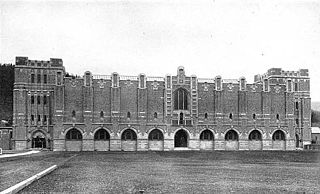
Hayes Gymnasium, completed in 1910, is the oldest section of the current Arvin Cadet Physical Development Center at the United States Military Academy. Originally built as an independent structure to replace the academy's previous Richard Morris Hunt-built gymnasium which had served between 1891 and 1910, it was part of a large contract bid awarded to the Boston architectural firm of Cram, Goodhue, & Ferguson in 1903.

James Benjamin Lampert was a United States Army Lieutenant General, Superintendent of the United States Military Academy (1963–1966), and early pioneer of nuclear weapons and nuclear power. Lampert was General Leslie Groves' executive officer as part of the Manhattan Project after World War II.

The Chapel of the Most Holy Trinity at the United States Military Academy is a Catholic church and place of worship for many members of the United States Military Academy Corps of Cadets. Completed in 1900, it is the oldest chapel on the West Point campus in continual use, although the 1836 Old Cadet Chapel, moved in 1910 to West Point Cemetery, is still in use for funeral services and weekly Lutheran denominational services. Most Holy Trinity Chapel was expanded in 1959.

The Old Cadet Chapel at the United States Military Academy is a church and location of funeral and memorial services. It is the oldest chapel at West Point, having originally been built in 1836. The chapel was originally located in the cadet area near present-day Bartlett Hall, but was disassembled brick-by-brick and moved to the West Point Cemetery when the current Cadet Chapel opened in 1910. Lutheran services are held at the old chapel on Sunday mornings during the school year.
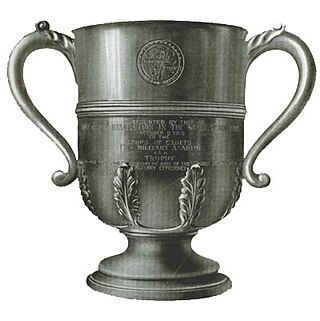
The Knox Trophy is the oldest military award of the United States Military Academy at West Point. The award was established on October 8, 1910, and is given annually by the Sons of the Revolution in the State of New York to the United States Military Academy cadet with the highest rating for military efficiency. Named in honor of General Henry Knox, the first Secretary of War, the original trophy, made by Tiffany & Company was originally kept on display in the office of the West Point Commandant.
Simeon Magruder Levy, also known as Simon Levy, was an officer in the United States Army. He was the second overall graduate and first Jewish graduate of the United States Military Academy.
